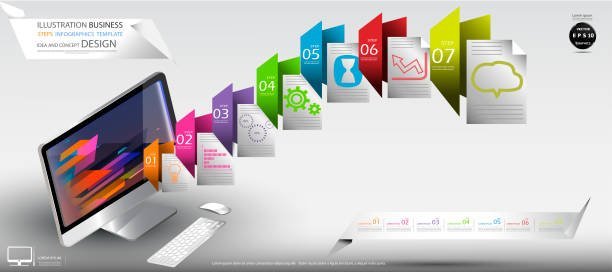How to Choose the Right Tech Stack for Web Development
Learn how to select the best tech stack for web development with expert insights on front-end, back-end, scalability, security, and development speed.

Choosing the right tech stack for web development is a crucial decision that determines the performance, scalability, and security of your website or application. Whether you are developing a simple website, an eCommerce platform, or an enterprise-grade solution, selecting the best technologies ensures a seamless user experience and efficient development process. This guide will help you navigate the process of choosing the most suitable tech stack with the help of experts and professionals.
What Is a Tech Stack?
A tech stack refers to the combination of technologies, programming languages, frameworks, and tools used to develop a web application. A complete tech stack consists of two main components:
Front-End Technologies
The front end, also known as the client side, includes everything users interact with on a website.
Best Front-End Technologies
-
HTML, CSS, and JavaScript: The foundation of any web application.
-
Front-End Frameworks: React, Angular, and Vue.js are among the top choices for developing interactive user interfaces.
-
UI Libraries: Bootstrap and Material UI help developers create responsive designs.
Back-End Technologies
The back end, or server side, is responsible for data processing, authentication, and business logic.
Best Back-End Technologies
-
Programming Languages: Node.js, Python, Ruby, PHP, and Java are popular choices.
-
Frameworks: Express.js, Django, Ruby on Rails, Laravel, and Spring Boot are widely used.
-
Databases: MySQL, PostgreSQL, MongoDB, and Firebase store and manage data efficiently.
-
Server Management: Apache, Nginx, and cloud-based solutions like AWS and Google Cloud.
Factors to Consider When Choosing a Tech Stack
Project Requirements
Your project’s size and complexity play a major role in selecting the right tech stack.
Considerations
-
Simple Websites: A basic HTML, CSS, and JavaScript setup may be sufficient.
-
eCommerce Platforms: Require robust frameworks like Magento, Shopify, or WooCommerce.
-
Enterprise Applications: Need scalable and secure technologies such as Java or .NET.
Scalability
If your website is expected to grow, choosing a scalable tech stack is essential.
Types of Scalability
-
Horizontal Scalability: Expanding infrastructure by adding more servers.
-
Vertical Scalability: Upgrading the current system to handle increased traffic.
Security Considerations
Security is a priority for any web application.
Key Security Features
-
Authentication and Authorization Mechanisms: OAuth, JWT, and multi-factor authentication.
-
Data Encryption: SSL/TLS encryption for secure data transmission.
-
Regular Updates: Use frameworks and libraries that receive regular security patches.
Development Speed
Fast development cycles help businesses launch projects quickly.
Ways to Speed Up Development
-
Low-Code/No-Code Platforms: Wix, WordPress, and Bubble for simple applications.
-
Pre-Built Libraries and Frameworks: React, Django, and Ruby on Rails reduce development time.
-
Agile Development Practices: Help teams adapt to changing requirements.
Community Support and Documentation
Choosing technologies with strong community support ensures access to experts who can provide help when needed. Open-source projects like React, Angular, and Node.js have active developer communities offering free resources, tutorials, and updates. Struggling with your Best PWA Development Company in the US? Let our professionals guide you through it!
Popular Tech Stacks for Web Development
MEAN Stack (MongoDB, Express.js, Angular, Node.js)
-
Best for: Single-page applications (SPAs) and real-time applications.
-
Pros: Full JavaScript stack, high performance, and easy scalability.
-
Cons: Steep learning curve for beginners.
MERN Stack (MongoDB, Express.js, React, Node.js)
-
Best for: Dynamic web applications and interactive UI development.
-
Pros: High performance, flexibility, and strong community support.
-
Cons: May require additional configurations for SEO optimization.
LAMP Stack (Linux, Apache, MySQL, PHP)
-
Best for: Traditional web applications and content management systems (CMS).
-
Pros: Cost-effective, open-source, and well-documented.
-
Cons: Less scalable compared to modern stacks.
Django + Python
-
Best for: Data-heavy applications and machine learning projects.
-
Pros: High security, rapid development, and built-in authentication.
-
Cons: Requires knowledge of Python.
.NET Stack (C#, ASP.NET, SQL Server)
-
Best for: Enterprise applications and financial services.
-
Pros: Strong security, excellent scalability, and Microsoft support.
-
Cons: Licensing costs can be high.
Choosing the Right Tech Stack for Your Business
Assess Your Business Goals
Before selecting a tech stack, consider:
-
Long-Term vs. Short-Term Goals: Will the project need frequent updates or maintenance?
-
Budget Constraints: Open-source solutions are cost-effective, while enterprise solutions may require licensing fees.
-
Target Audience: If mobile users are a priority, consider mobile-friendly frameworks like React Native.
Consult Professionals for Help
Hiring experienced professionals can help you make informed decisions. Many top web development services offer consultation on selecting the best tech stack tailored to your project needs.
Testing and Prototyping
Before committing to a tech stack, create a prototype to:
-
Evaluate Performance: Check how well the application runs under different loads.
-
Assess Usability: Gather feedback from users and developers.
-
Identify Potential Issues: Optimize code, security, and scalability.
Future-Proofing Your Tech Stack
Technology evolves rapidly, and future-proofing your stack ensures longevity.
Best Practices
-
Using Modern Frameworks: Stay updated with the latest technologies.
-
Ensuring Compatibility: Choose technologies that integrate well with other tools.
-
Regular Updates: Keep your software up to date for better security and performance.
Conclusion
Selecting the right tech stack for web development requires careful consideration of project requirements, scalability, security, and development speed. Whether you opt for MEAN, MERN, LAMP, or .NET, making an informed decision with the help of professionals ensures the success of your web application. By following best practices and consulting experts, you can build a high-performance and future-ready digital solution.
What's Your Reaction?















